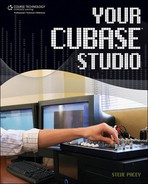Epilogue: After the Mix
I’ve given you a lot of information about Cubase and how you can use it in a home recording environment. Now it’s up to you to take it to the next level. Always keep your eyes and ears open for changes in technology, and check the Steinberg Web site (http://www.steinberg.net) once a month to keep up with the latest program updates and releases.
In this book, we’ve gone over everything from setting up a Cubase studio on your computer to mixing a project down to two tracks. You may be wondering, where do I go from here?
The first and easy answer is to use mastering software such as WaveLab to put the final touches on your mix and create a CD that includes other tracks you may have mixed (see Figure E.1). Mastering is a whole new art and can take years to perfect. If you want the best results for a finalized CD, you’re probably best off seeking the assistance of a professional mastering engineer. Once you have a mastered CD, creating MP3s and uploading your songs to iTunes or other sources is a breeze.
Figure E.1. Steinberg’s WaveLab mastering software, the next step in your audio adventure.

My goal was to point you in the right direction so that you know what’s out there. As you can see, Cubase is a massive program. We barely scratched the surface of the editors, and we didn’t even touch more than half of the program’s functions. If you are serious about creating music with Cubase, I highly recommend you check out my other book, MIDI Editing in Cubase. MIDI is one of the most powerful tools you can use for music creation. Whatever your needs, it’s important that you take this knowledge and put it to good use again and again. Practice makes perfect. The more you use the program, the faster and the better you’ll become at it.
